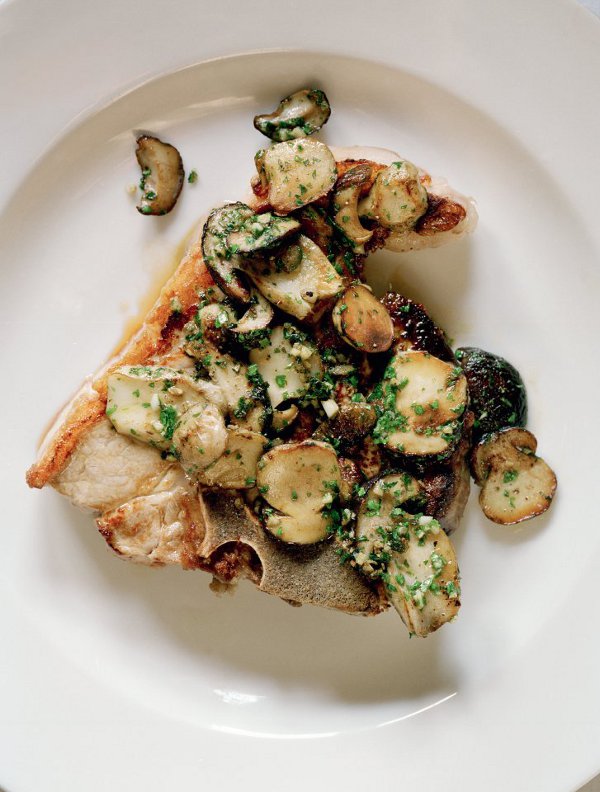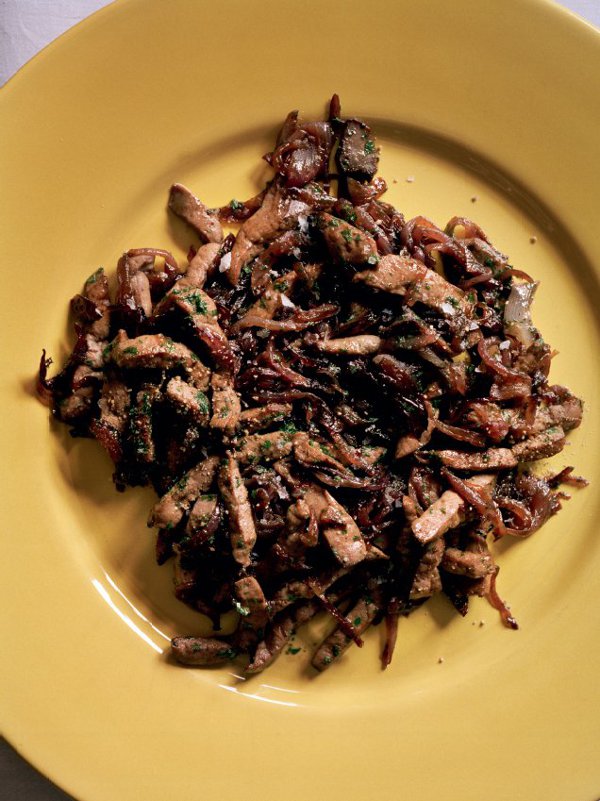Good Cook (20 page)
Authors: Simon Hopkinson

serves 2–3
2¼ lb oxtail joints (or lamb shanks), about 8 pieces, say
all-purpose flour
4 tbsp butter or ghee
1 lb onions, thinly sliced
4 cloves of garlic, sliced
1 sachet of nehari spice mix (2 oz—but if you want a milder curry, add a bit less)
18 oz water
3 oz creamed coconut
10–12 curry leaves (optional)
11 oz cherry tomatoes
1
1
/
3
lb waxy potatoes (medium-sized), peeled and cut into chunks
a little fresh coriander, chopped (optional)
A little over two years ago, I was taken by friends to the Lahore Kebab House, just off Commercial Road in London’s East End. I had long heard of this place and how basic it was. Full marks there: formica tables, strip lighting and absurdly tiny paper napkins; as I always get so messy with Indian food, I dispatched about twenty, I reckon. Anyway, such piddling details … More importantly, I was also promised that the food tasted wonderful. And so it did.
The finest dish of all, by far (though none were less than good and we ate for England) was a lamb shank “nehari.” This was a favorite of one friend, who assured me of its very particular, aromatic heat and superb gravy—of which there were copious amounts; so very good indeed it turned out to be that I found myself finishing it with a spoon, as soup. Just marvelous meat, too, so yielding and soft, falling off the bone in fondant lumps.
I was so impressed by the lamb nehari that I asked of the restaurant manager the blend of spices—I knew I could detect aniseed in there somewhere, at least. So he scuttled off to ask in the kitchen and returned with a colorful, cardboard packet. Well, although pleased indeed that I would easily be able to replicate this nehari at home, I was privately amused over the original idea that all the grinding and careful mixing of spices by the Lahore kitchen was so swiftly cast to the wind. And, by the way, in case you are wondering, I decided to use oxtail in the following recipe mainly because the price of lamb shanks on the day was of a similar price to a leg of lamb! Oxtail was half the price—and is every bit as tasty here, too.
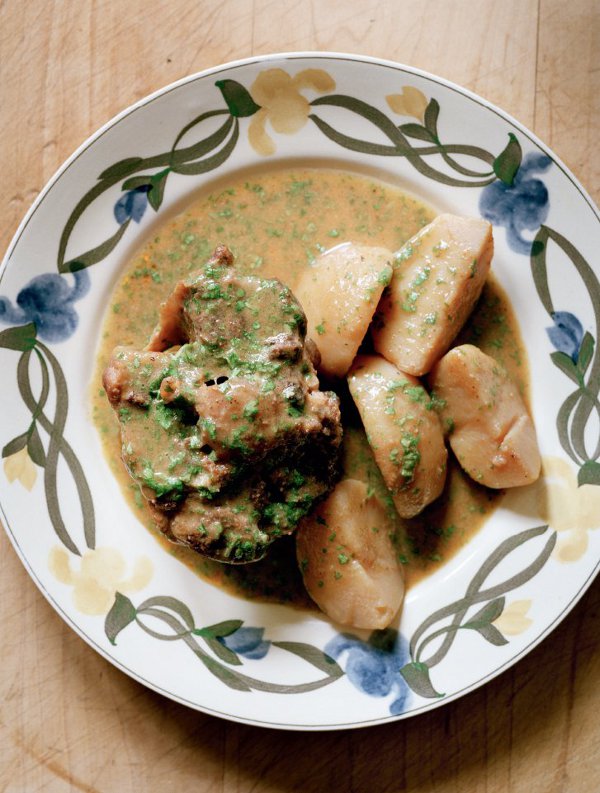
To buy a packet of Laziza nehari masala mix, either go to a good Asian supermarket or look online, where an excellent and entire range of super-fresh, vacuum-packed spice mixes is at your disposal.
Note: other brands that manufacture nehari masala mixes have, so far, come nowhere near the fragrance and heat of the Laziza brand. But that which really appeals to me, here, is that I can make a very good, particular curry without constantly updating individual spices, which so very quickly become stale.
One final note: do not add salt to the dish, as the spice mix includes this. And don’t follow the recipe on the packet; follow mine.
Preheat the oven to 300°F.
Generously coat the oxtail with flour. Melt the butter (or ghee) in a large, lidded pot and fry the joints until golden brown. Remove the meat and tip in the onions. Fry these until softened and starting to color. Add the garlic and continue to cook both for a further 5 minutes, or so. Sprinkle in the nehari spice mix and stir in, then cook the spice for a further 2–3 minutes. Pour in the water, bring up to a simmer and add the coconut, stirring it around until it has dissolved. Return the oxtail to the pot, bring back to a simmer and add the curry leaves if you have some. Put on the lid and cook in the oven for 1½ hours.
Remove from the oven and remove any excess fat from the surface using several sheets of paper towels; there will be more fat than you think, but leave a little behind for that authentic “curry” look. Now add the tomatoes and potatoes and stir them in. Bring back to a simmer, cover once more and return to the oven. Cook for a further 45 minutes to 1 hour, or until the potatoes are tender. Finally, stir in some chopped coriander, if using. Serve with some plain and fragrant, steamed basmati rice if you wish, but I am quite happy only to have the potatoes, as starch.
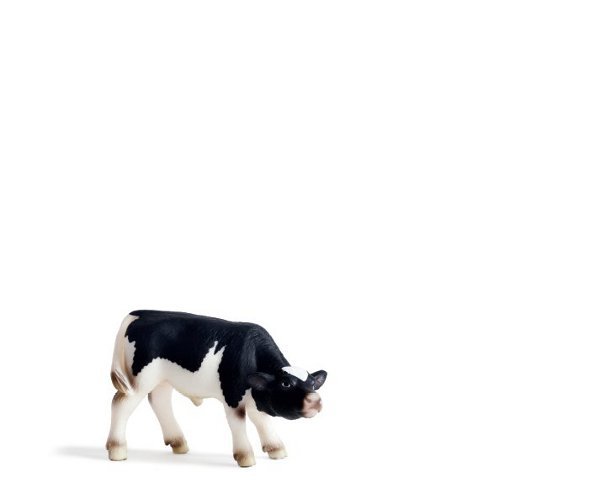
veal
serves 4, as a first course
for cooking the veal
approx. 1 lb veal fillet, well trimmed, to give a weight of around 13 oz
salt and freshly ground black pepper
2 tbsp olive oil
4–5 tbsp dry vermouth
juice of ½ a small lemon
2 cloves of garlic, bruised
1 sprig of rosemary, broken in half
for the anchovy mayonnaise
4 tbsp homemade mayonnaise (see Carpaccio recipe,
page 225
)
4 anchovies, chopped almost to a paste (or use a small processor, together with the mayonnaise)
squeeze of lemon juice, to taste
pinch or 2 of cayenne pepper
16–20 asparagus, depending on size, trimmed and partially peeled
One word of warning here: veal fillet is not exactly cheap. However, it is a most gorgeous cut, so tender, so pale pink and soft. I never understand, in fact, when so-called experts talk of meat, that a beef fillet steak, say, should be eschewed in favor of other cuts simply because it has less flavor and is only about tenderness. Well, geddaway. Of course it is! I mean, I love rump, sirloin, bavette and other, less tender cuts, too, but it entirely depends on what I feel like cooking and eating. A small fillet steak is a lovely thing, easy on the mouth and, when judiciously seasoned and quietly cooked in butter, remains one of my most favorite things to eat.
Actually, there is no doubt in my mind that the stumbling block here is cost. As an example, exactly the same misguided opinion applies to those who often say that they prefer crab to lobster. “Oh, do you now?” I say. “And why is that?” The usual reply is that it has more flavor. Poppycock. Quite simply, these are two completely different shellfish, absolutely wonderful to eat in their own particular way. But it is always that niggling cost, disguised as some gastronomic preference. To take the point to an almost surreal analogy,
I have yet to hear anyone say that they would rather eat a carrot than a parsnip (assuming one enjoys both, that is).
Ah well, irritable cook aside … Just enjoy costly and special things once in a while, as a treat. Having said all of that, you could always use a pork fillet here, if you want; and no, not quite the same, but a tasty alternative. Finally, if you are a fan of vitello tonnato, the Italian way with thinly sliced, cold veal and tuna sauce, the following marriage of flavors will be familiar to you.
Season the fillet of veal, then heat the olive oil in a heavy-based, lidded pot and quietly seal the meat on all sides, but only until pale golden, not at all browned. Add 1 tablespoon of vermouth, a squeeze of lemon juice and allow to bubble. Introduce the garlic and rosemary, partially cover the pot, and very, very gently braise the veal, while occasionally basting, for about 5 minutes. Turn the meat over, add a little more vermouth and lemon juice, then cook for a further 5 minutes. Do this perhaps twice more, turning the meat each time, and maybe sometimes without the lid, until the vermouth and lemon juice have reduced until syrupy, while also nicely coating the veal; total cooking time about 20–25 minutes. Remove the veal to a cold dish, (discard the garlic and rosemary) together with every vestige of juice, and cover with kitchen foil. Note: this method will give you a piece of very pink meat and, as the veal will now be left to completely cool, it will emerge just the rarer side of pale pink, once sliced.
To make the anchovy mayonnaise, simply mix the ingredients together until smooth.
To serve, slice the veal thinly, put on to 4 plates and spoon some of the anchovy sauce alongside. Cook the asparagus in fiercely boiling, salted water until tender—and not too crunchy, please. Drain the asparagus well, and arrange some on each plate. Trickle with a little of the veal cooking juices, together with some extra olive oil, if you like, and grind over a little black pepper to finish. The contrast of the cold veal, the salty-fishy mayonnaise and the hot asparagus is, if I might say, a luxuriously simple assembly.
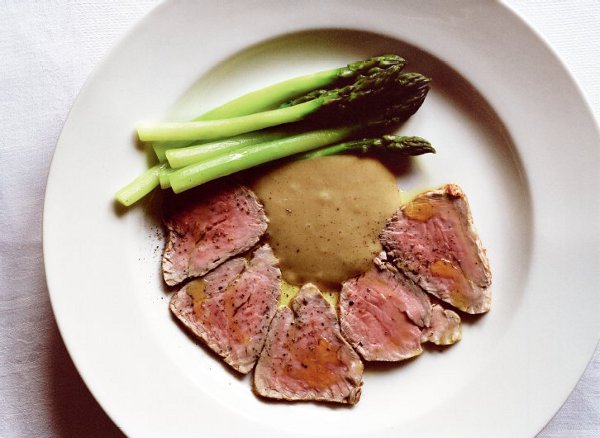
serves 2
2 veal chops
salt and freshly ground black pepper
olive oil
1 lemon, to serve
for the ceps (porcini wild mushrooms)
2 tbsp olive oil
4 oz fresh ceps, cleaned and thinly sliced
salt and freshly ground black pepper
2 tbsp butter
2 cloves of garlic and the leaves from 4 or 5 sprigs of parsley, finely chopped together (persillade)
What can I say? Here is a combination of such perfection—and really nothing to do with me—that it beggars belief. Grilled, succulent and pink veal, the finest wild mushroom known to man (don’t argue), chopped garlic and parsley. And that is it. You could do the thing using dried ceps, reconstituted in warm water, then drained, but I urge you to buy these some time in the very late summer-into-autumn, when occasional foraging is going on somewhere near you.
Heat a ribbed, stove-top grill until hot. Season the chops, brush them with a little olive oil and place on the grill. Cook for about 5–7 minutes on each side, until nicely marked from the grill; a good golden brown with a nicely pink interior is perfect. Leave them to rest in a warm place while you quickly cook the ceps.
Heat the olive oil in a large frying pan (non-stick is good, here) until moderately hot. Throw in the ceps, toss them around in the oil and add just a touch of salt and pepper. Cook them briskly with the aid of a wooden spoon, to both keep them separate and take on a little color at the same time. Add the butter, turn up the heat a touch and allow it to sizzle. Only now throw in the garlic and parsley, toss around to mix and then immediately spoon over the chops. Hand a cut lemon at table for squeezing over, if you wish.
